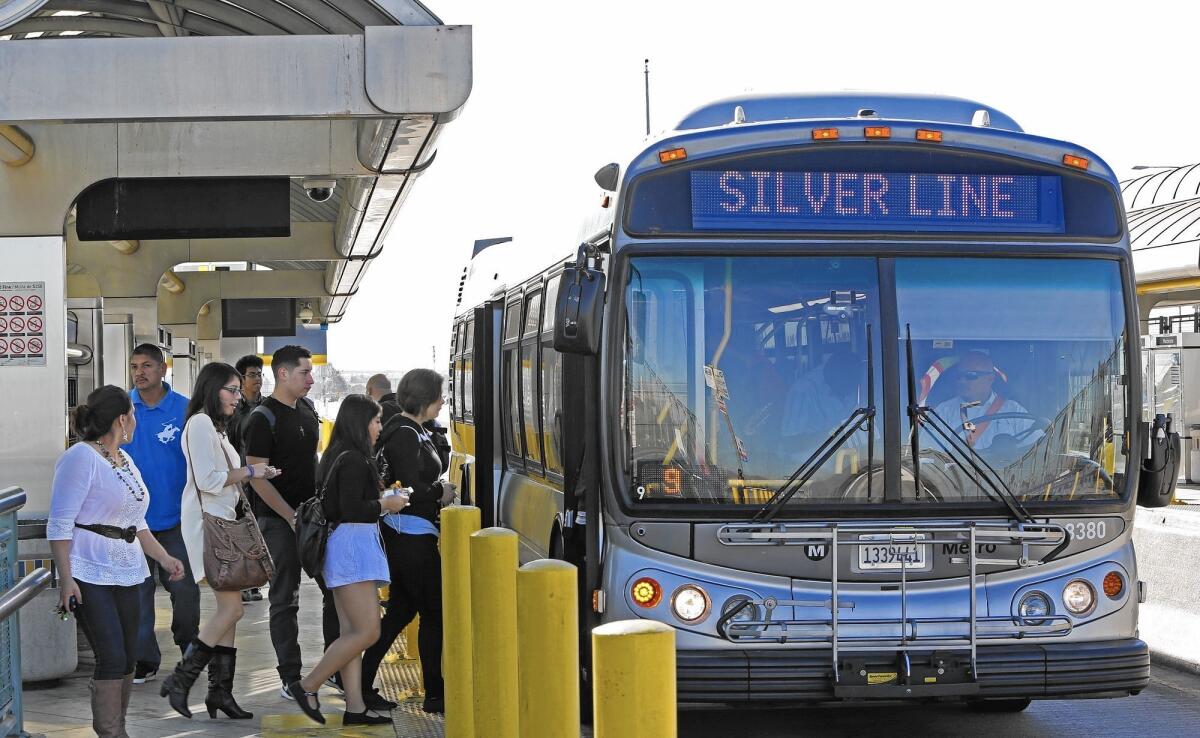California Commute: A cleaned-up, safer Harbor Transitway puts more commuters on the bus

- Share via
A decade ago, the 11-mile bus way down the middle of busy Interstate 110 looked like a white elephant.
Ridership was far below projections. The line stopped a mile short of downtown Los Angeles, requiring time-consuming transfers. Stations built in the freeway median were noisy, polluted and appeared uninviting, if not unsafe, especially at night.
But things have begun to turn around for the so-called Harbor Transitway between Los Angeles and the South Bay. Since 2004, bus boardings for the route have more than quadrupled, from a paltry 3,000 per weekday to upward of 13,600 this year.
That’s still a fraction of the 65,200 boardings planners once projected, but evidence of significant progress, transit officials say.
“We’ve been making improvements,” said Scott Page, manager of planning services for the Los Angeles County Metropolitan Transportation Authority. “Service has been added. There are better bus connections, increased security, and the stations are cleaned up. All of this fits into more ridership.”
The transit-way buses, which now share lanes with toll-paying and carpooling motorists, run between the 37th Street Station at USC and the Pacific Coast Highway Station in Wilmington. There are eight bus stops, including the Harbor Gateway Transit Center on 182nd Street in Gardena, which includes an 800-space park-and-ride facility.
Gardena Municipal Bus Lines, Metro’s Silver Line, Metro Locals, the Los Angeles Department of Transportation’s Commuter Express, the Orange County Transportation Authority and Torrance Transit operate along part or all of the route. On the Silver Line, the most popular service, the basic one-way fare, end-to-end, is $2.50.
“It’s been great,” said Jason Roach, a Caltrans worker who commutes by bus daily from the Harbor Gateway station to downtown Los Angeles. “They really put it together with the Metro Silver Line. It beats driving.”
Caltrans designed and built the bus route as part of a $500-million project to widen the 110 Freeway and add carpool and bus lanes, including three miles of elevated roadway south of downtown. The first bus used the route in 1996 and Metro manages the lanes.
Despite low-fare promotions and above-average transit use in the South Bay, ridership remained stuck at about 3,000 boardings a day for several years.
When questions arose about the transit way’s anemic performance in 2004, Metro officials complained that Caltrans built it without sufficient coordination with the county transit agency or its predecessor, the Southern California Rapid Transit District. Caltrans officials maintained that the route needed more Metro-funded bus service and better transit connections.
Critics noted that the transit-way stopped near Adams Boulevard, south of the center city employment hub. In addition, Metro’s Blue Line light-rail service between Long Beach and Los Angeles served as cheaper competition.
Five of the transit-way stations were built in the freeway median, making them difficult to reach, noisy and exposed to exhaust emissions. With few riders and only sporadic police patrols, the stations attracted vagrants
A study by USC’s METRANS Transportation Center described the stops as empty, forlorn, “totally unfriendly” and “extremely unsafe for pedestrian access.”
A turning point came in December 2009 when Metro launched its Silver Line rapid bus service. In addition to running the length of the transit way, the new line continued through downtown and east along the El Monte Busway, creating a 26-mile system operating largely on faster, limited-access freeway lanes.
Metro later increased the frequency of Silver Line buses, added weekend service and improved connections to other transit lines.
“A lot has changed in the past decade,” said Darin Chidsey, director of public affairs for the Southern California Assn. of Governments, a regional planning agency. “The Silver Line has connected downtown to the South Bay like never before.”
Today, ridership on the transit way compares favorably with many high-performing Metro bus lines, which have 10,000 weekday boardings or more.
“The number of passengers is definitely up,” said Richard Song of Torrance, who commutes on the Silver Line to work in downtown Los Angeles. “At rush hours, the stations are really crowded.”
More improvements accompanied the 110 ExpressLanes project, a tollway that opened in November 2012. Bike lockers, better lighting, a sheriff’s substation, security cameras and noise insulation were added to the transit-way stations. Gardena also plans to add service to the route.
Last week, Goodwin Turner, also of Torrance, boarded the Silver Line at the Harbor Gateway Transit Center and headed to the Los Angeles Auto Show at the L.A. Convention Center. He noted that parking at the popular event would have cost him $20. His off-peak fare as a senior citizen was just 95 cents one way.
“You can’t beat it,” Turner said.
Follow LADeadline16 for transportation news.
More to Read
Sign up for Essential California
The most important California stories and recommendations in your inbox every morning.
You may occasionally receive promotional content from the Los Angeles Times.










